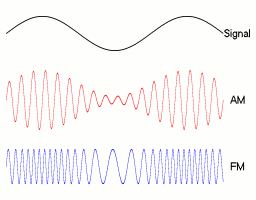In telecommunications and signal processing, frequency modulation (FM) is the encoding of information in a carrier wave by varying the instantaneous frequency of the wave. This contrasts with amplitude modulation, in which the amplitude of the carrier wave varies, while the frequency remains constant.
In analog frequency modulation, such as FM radio broadcasting of an audio signal representing voice or music, the instantaneous frequency deviation, the difference between the frequency of the carrier and its center frequency, is proportional to the modulating signal.
Digital data can be encoded and transmitted via FM by shifting the carrier's frequency among a predefined set of frequencies representing digits - for example one frequency can represent a binary 1 and a second can represent binary 0. This modulation technique is known as frequency-shift keying (FSK). FSK is widely used in modems and fax modems, and can also be used to send Morse code. Radioteletype also uses FSK.
Frequency modulation is widely used for FM radio broadcasting. It is also used in telemetry, radar, seismic prospecting, and monitoring newborns for seizures via EEG, two-way radio systems, music synthesis, magnetic tape-recording systems and some video-transmission systems. In radio transmission, an advantage of frequency modulation is that it has a larger signal-to-noise ratio and therefore rejects radio frequency interference better than an equal power amplitude modulation (AM) signal. For this reason, most music is broadcast over FM radio.
Frequency modulation has a close relationship with phase modulation; phase modulation is often used as an intermediate step to achieve frequency modulation.

